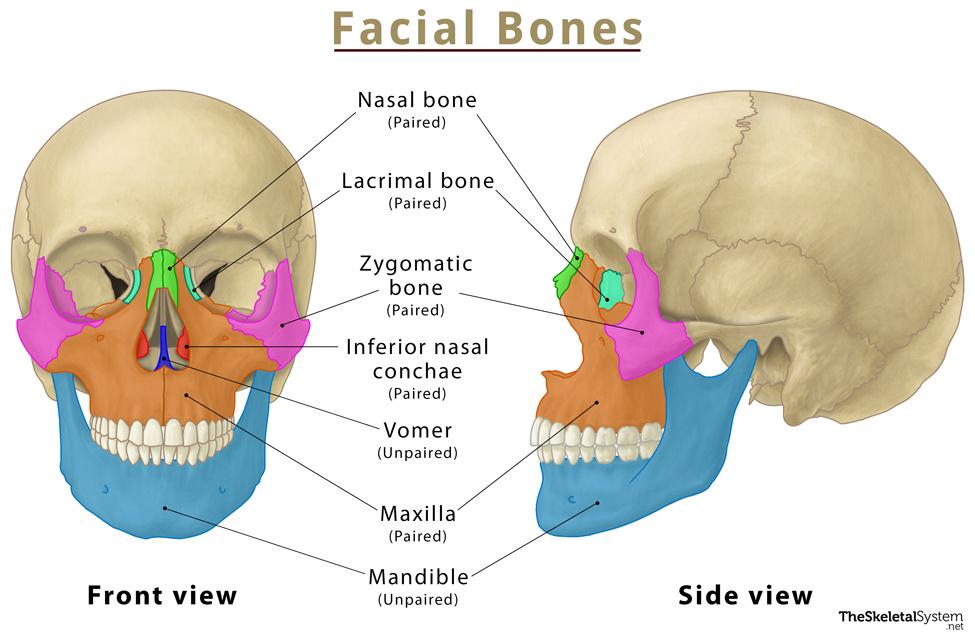Facial Bones
What are the Facial Bones
The human skull comprises 22 bones, among which 14 facial bones form the front portion of the skull, known as the facial skeleton or viscerocranium. There are six paired and two single facial bones, which become 14 in total. Among them, some are irregular, while some are flat.
The remaining 8 skull bones form the cranium that protects the brain.
How Many Bones are There in the Face
The 14 bones that make up the face or viscerocranium are as follows:
- Zygomatic bone (paired)
- Lacrimal bone (paired)
- Inferior nasal conchae (paired)
- Nasal bone (paired)
- Palatine bone (paired)
- Maxilla (paired, but fused)
- Vomer (unpaired)
- Mandible (unpaired)
These bones articulate with their neighboring ones via direct or indirect joints and sutures, forming the nasal and oral cavities, the orbits of the eyes, and the sinuses.
Functions
- Provide a structural framework for the face. So, the look or form of our face is due to our facial skeleton.
- Support the soft tissues of the face, head, and neck.
- Protect a part of the brain.
- Encase and protect the sensory organs — nose, eye, and tongue.
- Feature multiple foramina (holes) that allow passage to several important cranial nerves and blood vessels.
- Provide plenty of muscular and ligament attachment points that help to produce a wide variety of facial expressions, like frowning and smiling. These attachments are also vital for chewing, swallowing, and speech.
Anatomy of the Facial Skeleton
The facial skeleton or viscerocranium is formed by the 14 bones mentioned above. Except for the mandible, these bones are joined by sutures via synarthrodial or immovable joints. Here is a basic outline for the bones of the face:
1. Zygomatic: Located at the cheek region below the eye sockets on either side. Also known as the cheekbone, it gives structure to the cheek and articulates with the temporal, frontal, maxilla, and sphenoid bones.
2. Lacrimal: Located at the edge of the inner corner of each eye, forming the medial wall of the eye orbit and nasal cavity. They articulate with the maxilla, ethmoid, frontal bone, and inferior nasal concha. These are the smallest facial bones.
3. Nasal: These two slender bones are located at the bridge of the nose, giving shape to the nose. They also join the frontal bone, ethmoid bone, and maxillae.
4. Inferior Nasal Conchae: Located within the nasal cavity, these bones complete the nasal cavity by forming the side and lower wall. They articulate with the maxilla, palatine, lacrimal, and ethmoid bones.
5. Palatine: These two L-shaped bones at the back of the nasal cavity form the hard palate. They articulate with each other as well as with the maxilla, sphenoid, ethmoid, vomer, and inferior nasal concha.
6. Maxilla: These two bones form the upper jaw and hard palate by fusing in the midline via a suture. They contain maxillary sinuses and sockets for the teeth along their lower margin. It articulates with the cranial bones frontal and ethmoid, as well as the nasal, zygomatic, lacrimal, palatine, vomer, and inferior nasal concha. This makes the maxilla the facial bone with the highest number of articulations.
7. Vomer: This thin, flat bone forms the lower portion of the nasal septum. It articulates with the maxilla, palatine, and ethmoid bones.
8. Mandible: It is the largest, strongest, and only movable facial bone. It forms the lower jaw and contains sockets for the teeth along its upper margin. The bone articulates with the cranium base at the temporomandibular joint (TMJ).
Facial Bones Mnemonic
The following sentence, holding the acronyms of all 8 types of facial bones, will be an easy way to remember their names.
My Mouth’s Palate Never Liked Zucchini In Vinegar.
Breaking the mnemonic:
M: Maxilla
M: Mandible
N: Nasal Bone
Z: Zygomatic Bone
I: Inferior Nasal Conchae
V: Vomer
Development of the Facial Bones
Most facial bones are usually derived from the neural crest cells. However, some of them may also develop from the sclerotome, which arises from the somite block of the mesoderm.
FAQs
Ans. The primary function of sinuses is to produce mucus that moisturizes the inner nasal cavity. This mucus layer prevents pollutants, micro-organisms, dust, and dirt from entering the body through the nose.
Ans. As we age, the facial bones also lose density like other bones. Due to this, the bones start to shrink, causing a loss of support to the visible facial features.
References
- Bones of the Skull – Teachmeanatomy.info
- How Many Facial Bones are There? – Study.com
- Facial Bone – Sciencedirect.com
- Facial Bone Anatomy – Emedicine.medscape.com


